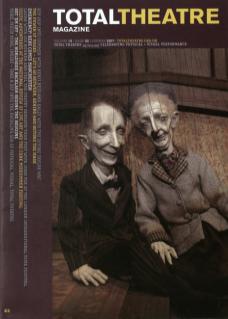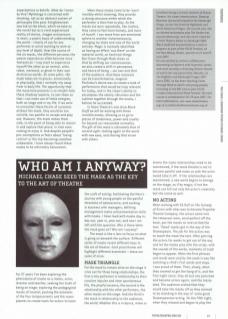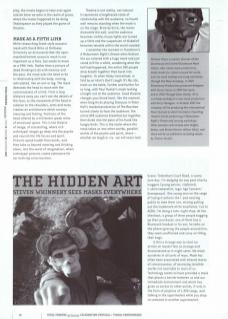For 27 years I've been exploring the phenomena of masks as a maker, actor, director and teacher; seeking the truth of being on stage, exploring the pedagogical masks of neutral; pushing the extremes of the four temperaments and the seven planets to create tools for actors to learn the craft of acting; facilitating the Hero's Journey with young people on the painful threshold of adolescence; and working in business with managers, defining management styles and presentation skills with masks. I have lived with masks day in, day out, year in, year out, and now I am left with the question: Who is there when the mask goes on? Who am I anyway?
The mask is like a lens to focus on what is going on beneath the surface. Different styles of masks reveal different keys to the art of theatre. Each practitioner will highlight different essentials – these are some of mine:
Mask Triangle
For the mask to remain alive on the stage it cries out for three living relationships: the first is the performer in relationship to their creative impulse and inner spontaneous life, the playful essence; the second is the relationship with the other performers, the other masks on the stage. And the third is the mask in relationship to the audience, the world. Whether this is in dance, mime or drama the same relationships need to be maintained, if the mask theatre is not to become painful and make us wish the actor would take it off. If the relationships are maintained, a new world begins to emerge on the stage, as if by magic, if not the mask can kill not only the actor's creativity but the scene as well.
No Acting
When working with Ed Hall on The Comedy of Errors with what was to become Propeller Theatre Company, the actors came into the rehearsal room, word perfect off the book, put the masks on and recited the text. 'Dead' masks got in the way of the Shakespeare. The job for the actors was to teach the mask the text. After policing the actors for weeks to get out of the way and let the masks play with the script, with the sounds of the words, moments of truth began to appear. When the first phrases and words were said by the mask it was like watching a child's first words and steps. I was proud of them. Then, slowly, when they seemed to get the hang of it, and the first night came, they all but one panicked and became actors again, and the masks died. The audience wished that they would take the masks off as they seemed to be standing in the way of some good Shakespearean acting. On the fifth night, when they relaxed and began to play the play, the masks began to take over again and we knew we were in the realm of grace, where the masks happened to be doing Shakespeare as they played the game of theatre.
Mask as a Fifth Limb
While researching Greek style acoustic mask with David Wiles at Holloway University we discovered that the open-mouthed helmet acoustic mask is not important as a face, but needs to move as a fifth limb. Rather than a picture of dead thinking to do with memory and the past, the mask asks the head to be in relationship with the body, moving, articulated, like an arm or leg. The mask demands the head to move with the consciousness of a limb. From a long distance away you can't see the details of the face, so the movement of the head in relation to the shoulders, arms and torso creates an architecture which conveys meaning and feeling. Positions of the head altered by a millimetre speak miles of emotional space. This is the theatre of image, of storytelling, where rich archetypal images go deep into the psyche and nourish the life forces and spirit. Pictures speak louder than words, and they take us beyond meaning and thinking alone, into the world of imagination, where archetypal pictures create substance for our evolving consciousness.
Theatre is not reality, not natural. It represents a heightened state of relationship with the audience; no fourth wall remains standing when the mask is on the stage. Brick by brick, the masks dismantle the wall, and the audience becomes visible; house lights are turned up a little and the suspension of disbelief becomes tenable within the world created.
I remember the moment in Footsbarn's A Midsummer Night's Dream when Bottom the ass entered with a huge mask and just stood still for a while, wondering what the hell had happened, the entire 500 people drew breath together then burst into laughter. Or when Haley Carmichael, in Told by an Idiot's Don't Laugh It's My Life, leant on the table, further and further for so long, with Paul Hunter's mask looking straight out at the audience. Good theatre changes your blood level, like the moment when Greg Hicks, playing Dionysus in Peter Hall's masked production of The Bacchae, turned slowly to face the audience: the entire 800 audience breathed out together, then dived into the palm of his hand like hungry birds. This is the realm where the mask takes us into other worlds, parallel worlds of the psyche and spirit, where – whether we laugh or cry – we will never look.


